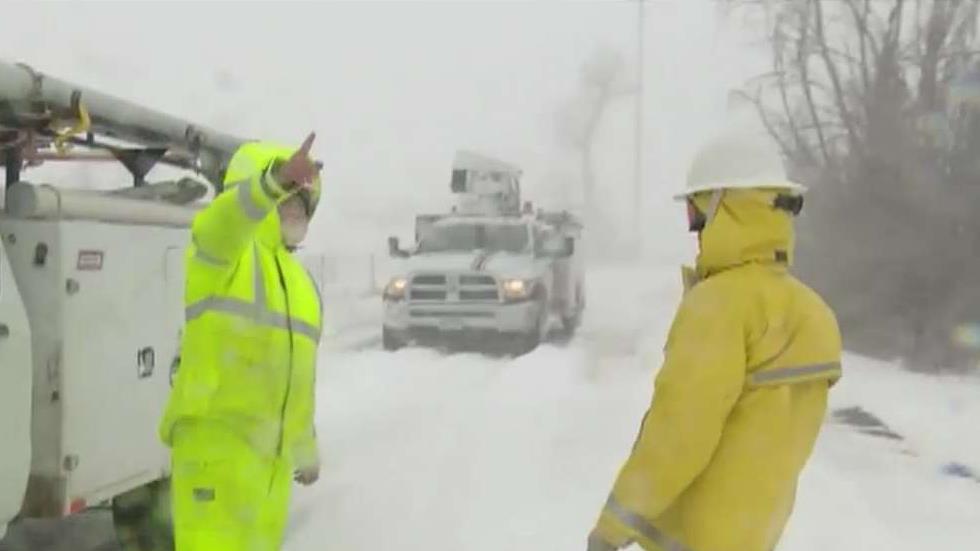This upcoming winter may be warmer overall, but government forecasters are advising that there may be some "large swings" due to volatile weather patterns.
The National Oceanic and Atmospheric Administration said in its winter outlook that warmer-than-average temperatures are forecast for much of the U.S. this winter, with a wetter-than-normal season from December through February across the northern parts of the country.
"No part of the U.S. is favored to have below-average temperatures this winter," according to the outlook.
But forecasters admitted Thursday that global climate patterns that typically influence winter weather patterns are weak this year, leading to complicated forecasts.

This winter may be warmer, but more volatile, according to forecasters. (Gary Hershorn)
"I would say that this is not one of our most confident forecasts," Mike Halpert, deputy director of NOAA’s Climate Prediction Center, said on a conference call with reporters.
WINTER TO FEATURE 'POLAR COASTER' MIX OF FRIGID TEMPERATURES, SNOW: FARMERS' ALMANAC
Due to the lack of an El Niño or La Niña, there's a lack of strong climate patterns that are leading to neutral conditions expected to last until the spring.
“Without either El Niño or La Niña conditions, short-term climate patterns like the Arctic Oscillation will drive winter weather and could result in large swings in temperature and precipitation,” Halpert said.
Forecasters said that short-term climate patterns limit the predictability to a couple of weeks, which Halpert said is why NOAA is relying more heavily on computer model forecasts this year.

Even during a warmer-than-average winter, periods of cold temperatures and snowfall should be expected, according to the NOAA. (Gary Hershorn)
Government forecasters last year said to expect a warmer than normal winter, which turned out to be wrong as the "Polar Vortex" brought brutal cold to the Midwest and Northeast in late January into February. Halpert told reporters that since the mid-1990's government-issued temperature outlooks are generally 30 to 35 percent more accurate on temperature than random guesses.
Forecasters are confident, however, that the weather will be warmer and wetter in Alaska and Hawaii, according to Halpert.
There is also a "modest" probability for a warmer winter in large parts of the U.S., from the West across the South to the East Coast.

A large swath of the U.S. may experience a warmer-than-average winter, according to forecasters. (NOAA)
"The Northern Plains, Upper Mississippi Valley, and the western Great Lakes have equal chances for below-, near- or above-average temperatures," according to forecasters.
DALLAS STARS' TYLER SEGUIN LOSES HOME IN TORNADO, SAYS IT'S AN 'EXTREMELY SAD SIGHT TO SEE'
In terms of precipitation, wetter-than-average conditions are likely in Alaska and Hawaii, in addition to parts of the Northern Plains, Upper Mississippi Valley, the Great Lakes and parts of the Mid-Atlantic and Northeast.

Above-normal precipitation is forecast this winter in Alaska, Hawaii, and northern parts of the country. (NOAA)
"Drier-than-average conditions are most likely for Louisiana, parts of Texas, Mississippi, Arkansas and Oklahoma as well areas of northern and central California," according to NOAA.
A "bomb cyclone" over the spring helped usher in significant and historic flooding across the central U.S. that impacted nearly 17 million people. But by summer and early fall, drought developed across much of the South, affecting 20 percent of the country.
"Abnormally dry conditions are present across much of the Southern U.S., with areas of the most severe drought in the Four Corners region of the Southwest, central Texas and parts of the Southeast," according to forecasters. "Drought is expected to improve in portions of the Southeast, Mid-Atlantic, Alaska, and Hawaii, while persisting in central Texas and the Southwest."
NOAA stresses that seasonal outlooks do not include seasonal snowfall amounts as those are generally not predictable more than a week in advance.
"Even during a warmer-than-average winter, periods of cold temperatures and snowfall are expected," the agency states.
CLICK HERE FOR THE FOX NEWS APP
AccuWeather has said in its own winter forecast that an active weather pattern will take hold in the Northeast, with stormy conditions as the Southeast sees more rain. The Pacific Northwest will stay mild, while Arctic cold will make a return mid-winter across the Midwest.
The Farmers' Almanac, which says it bases its long-range forecast "on a mathematical and astronomical formula developed in 1818," has said "bitterly cold winter conditions" will be in place from areas east of the Rockies all the way to the Appalachians, with the coldest outbreak of the season arriving during the final week of January and lasting through the beginning of February.
The Farmer's Almanac said that this upcoming winter will be "filled with so many ups and downs on the thermometer, it may remind you of a 'Polar Coaster.'"






















